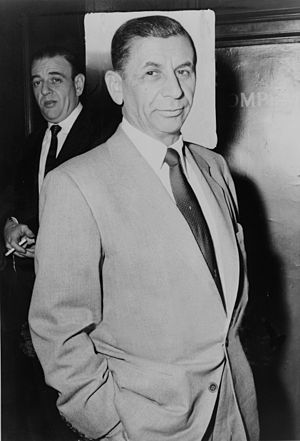La Cosa Nostra Meets Kosher Nostra
 Meyer Lansky Retired Judge and Mafia Historians Reveal the True Alliance Between the Italian and Jewish Mobsters of Brooklyn
Meyer Lansky Retired Judge and Mafia Historians Reveal the True Alliance Between the Italian and Jewish Mobsters of BrooklynBROOKLYN — Italian and Jewish mobsters, respectively ‘La Cosa Nostra’ and ‘Kosher Nostra,’ came together to make money in America during the 1940s — but the dividing lines between the two groups never fully went away.
“The Guineas are comin’! Let’s get the Sheenies!” the Jewish Brownsville Boys would shout as they chased Ocean Hill Italians from back up to Atlantic Avenue, writer Ron Ross described of a typical Brooklyn scene during a panel last week on Italian and Jewish mob history, “La Cosa Nostra Meets the Kosher Nostra: From the Ghetto to the Boardroom.”
Then, by the time they got there, the Italians would turn around, grab horse manure from the street and fling it at the Jews, chasing them back into their own turf.
In a few years, the Brownsville Boys would be organizing with Italians to form Murder, Inc., which operated out of a Brownsville candy store and was estimated to be behind 400 to 700 murders as enforcers for the Mafia in New York City. Jews and Italians united, most of all, for profit.
“There’s a stereotype that Jewish guys were the bookkeepers and Italians were enforcers. That’s not true,” said panelist Eric Dezenhall, who is the author of “The Devil Himself.” “There were plenty of intelligent Italians who kept the books, and there were plenty of psychotic, violent Jewish guys.”
“It was all about making money,” added New York University professor Roberta Newman of the union between the two groups.
As Dezenhall put it, “There were some guys who were tribal, but some who just cared about making money. It wasn’t all guys who wanted to go into a restaurant and have everyone go ‘Oooh.’”
Retired Manhattan Supreme Court Justice Edwin Torres, famed as the author of “Carlito’s Way,” which later spawned the 1980s mobster movie starring Al Pacino, moderated the panel and introduced the subject from a historical perspective.
In Italy, where famine, draught and political unrest ravaged the land during the late 1800s, people left in droves for the United States, just like Jews in Russia and Poland, who were living in shtetls and villages and subjected to anti-Semitism and pogroms, Torres said.
The second-generation immigrants, Jews and Italians who were born in America, were the ones who turned to crime, panelists said.
“The history of organized crime doesn’t have to do with ethnic groups, it has to do with when you got here,” Dezenhall said.
As Ross said about the Brownsville Boys who later became founding members of Murder Inc., “Their parents never had land of their own before or an apartment of their own before. … Clash for turf was a daily thing.”
The panel said that while Italian and Jewish mobsters worked together, real loyalty only existed between a few partners and friends — not between the groups as a whole.
Ross said La Cosa Nostra shunned some of its members who were overly loyal to Jewish mobsters.
A lot of the discussion focused on ironic differences between the two groups.
Dezenhall said that one Italian mobster, Lucky Luciano, told a Jewish mobster, Meyer Lansky, “One day, my son will run the Brooklyn waterfront.” The Jewish mobster replied, “My son works at NASA.”
“Jewish guys never brought their kids in [to the mob],” Dezenhall said.
And divisions between ethnic groups were part of life back then, Torres said.
Torres told the audience at this talk organized by the Museum of the American Gangster that as a Puerto Rican growing up in Spanish Harlem, he would get beat up by the Italian Redwings if he walked east past Park Avenue; or by the black gangs if he went west of Fifth Avenue.
Bummy the Brownsville Boxer
Ross, who grew up on the border of East Flatbush and Brownsville, heard many of these stories from his uncle, who owned a Brownsville gas station, and from his cousin, who trained with boxer Al “Bummy” Davis, who was known for standing up to the mobsters in Brooklyn.
Bummy was 5-foot-9 and chunky, but Ross said that when his cousin would come home from Beecher’s Gym in Brownsville and tell him stories about Bummy, “that made him 10 feet tall in my eyes.”
Ross’ book, “Bummy Davis vs. Murder, Inc.,” tells much of the history of the Italian and Jewish mobster alliance, but focuses on one particular event, when Bummy refused to throw a fight for the profit of one of Murder, Inc’s toughest killers, Abe Reles.
When Reles and his cohorts confronted Bummy on the sidewalk in the middle of the day, Bummy refused, and instead put his dukes up, snarling, “You want me, I’ll take all of ya’s! C’mon! I’ll take all of ya!’” He was left alone after that.
“It was the talk of Brownsville,” Ross said, and he claims in his book that Bummy’s actions even inspired some former Murder, Inc. henchmen to turn state’s evidence, leading to the eventual downfall and arrest of many Murder, Inc. members.
Ross also claims to have solved the mystery behind “The Canary Sang But Couldn’t Fly” — the mysterious death of Reles, thrown out of a guarded room at the Half-Moon Hotel in Coney Island after he was arrested and turned informant for prosecutors.
Mobsters Albert Anastasia and Franky Carbo whacked Reles by throwing him out the window, Ross claims, after Lansky paid the five policemen guarding Reles to “go to sleep.”
Ross said that he has this information firsthand from connections in the boxing world, which Carbo ruled back in the day, but said that he can’t reveal his sources on this information just yet.
http://www.brooklyneagle.com/categories/category.php?category_id=4&id=45091








0 comments:
Post a Comment